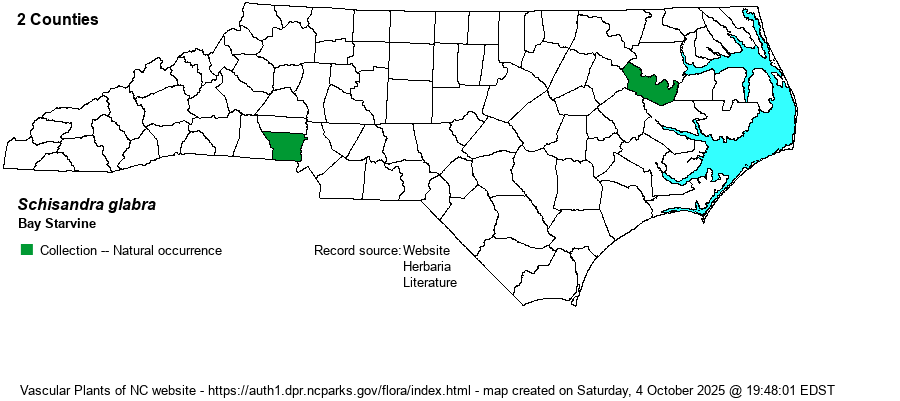| Author | (Brickell) Rehder | |
| Distribution | Known from only two sites in the state: Gaston County (southern Piedmont) and Martin County (east-central Coastal Plain). There has been some discussion whether the Martin County location is a native one, as it is far east of the known range and as plants do not seem to flower or fruit.
A scarce Southern species, ranging from NC, KY, and AR south to the FL Panhandle and LA. Only a few known sites/counties known in NC, SC, KY, and TN. Also Mexico. | |
| Abundance | Extremely rare, known from only two sites, both of which seem to still be extant. This is a State Threatened species, though it deserves to be listed as State Endangered. | |
| Habitat | In NC, it is found in very rich soils of floodplain “islands” and rich (mafic) slopes in deciduous forest. This is a species of high pH soils. |
| Phenology | Blooms in May and June, and fruits in July and August. | |
| Identification | This is a deciduous woody vine, normally not climbing high into trees but often twining over lower vegetation or sprawling over the ground. It has alternate, medium-sized leaves, smooth and often shiny above; some leaves may be clustered on short side spurs. They are elliptic and entire, averaging about 3-4 inches long, on long stalks. The rather small flowers are deep red, dangling on long stalks from leaf axils. The fruit consist of red berries, on a drooping stem. Flowers and fruit are seldom seen in NC, however, and thus people need to be prepared to identify this somewhat ordinary looking vine by its leaves. The main confusion is with Climbing Hydrangea (Decumaria barbara), which may grow with Schisandra, but its leaves are opposite, though both can have leaves on short spurs. Decumaria leaves tend to have some small crenations or serrations along the outer margins. | |
| Taxonomic Comments | None
| |
| Other Common Name(s) | Starvine, Magnolia-vine, Climbing-magnolia | |
| State Rank | S1 | |
| Global Rank | G3 | |
| State Status | T | |
| US Status | | |
| USACE-agcp | | |
| USACE-emp | | |

